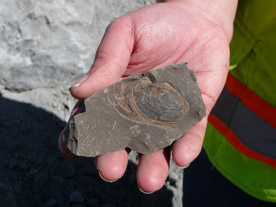Caltrans is trying to finish the fourth bore of the Caldecott Tunnel within the next two years, in order to ease traffic congestion in the East Bay. But paleontologists on the project say they aren't being given enough time to preserve important fossils.

At both ends of the new tunnel, crews grind rock 24 hours a day. Outside the dig, trucks dump literally tons of material. That's where you’ll find paleontologist Kristen McCallister, small hammer in hand, sifting through the piles.
“I just pretty much find a big rock or little, depends, and start breaking off the edges,” McCallister says, hammering a piece of siltstone. “We could find a whale in here or little tiny fish bones that are maybe half a centimeter.”
Caltrans is drilling through rock layers that were deposited between five and 11 million years ago, during the Miocene Epoch. It’s a time when the Bay Area was home to prehistoric camels, rhinoceros and horses.
“We found a wolverine. Not the sort of wolverine you would think about modern day. This wolverine was bigger than a grizzly bear,” says McCallister.
